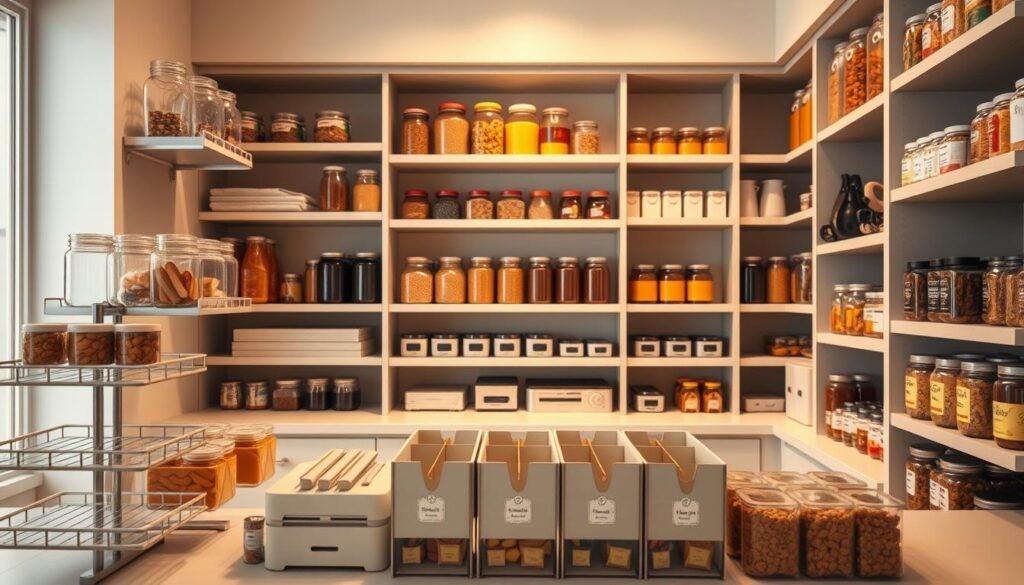
Are you tired of rummaging through cluttered shelves to find that one ingredient you need? You’re not alone! A staggering number of home cooks waste time and food due to disorganized kitchen storage.
A well-organized pantry is more than just a pretty sight; it’s a game-changer for meal prep and food waste reduction. In this comprehensive guide, we’ll walk you through expert strategies to transform your chaotic pantry into a functional, efficient kitchen hub.
Discover practical tips that real people use to maintain organized pantries in their everyday lives. From preventing avalanches of falling cans to creating visibility and accessibility, we’ll address common frustrations and provide adaptable solutions for your kitchen organization needs.
Key Takeaways
- Transform your chaotic pantry into a functional, efficient space.
- Discover practical tips for maintaining organized pantries.
- Prevent avalanches of falling cans and create visibility.
- Implement adaptable solutions for your kitchen organization needs.
- Maximize your kitchen’s potential with expert pantry space management tips.
Understanding the Importance of Pantry Organization
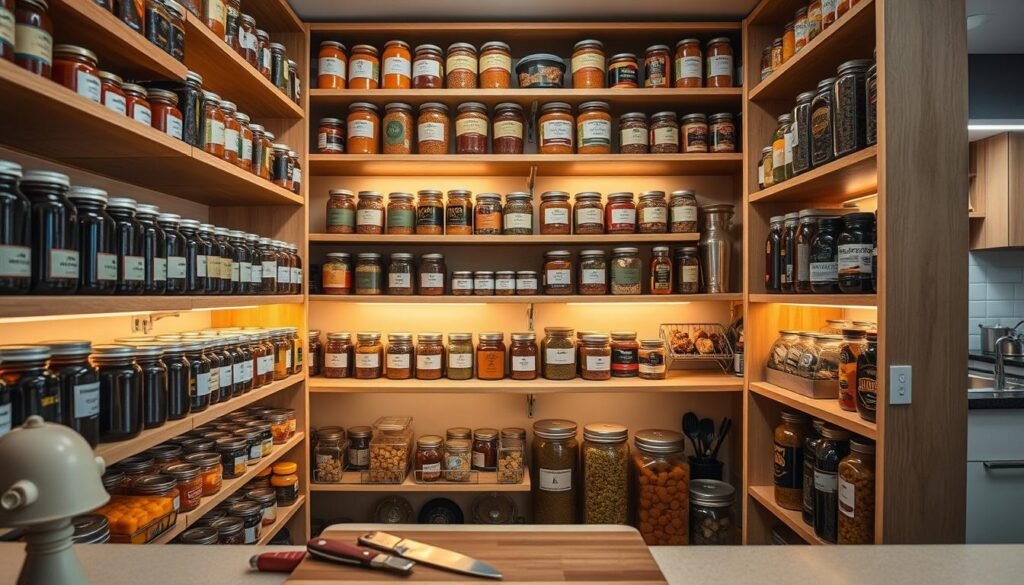
A well-organized pantry is more than just a tidy space; it’s a game-changer for your kitchen. It’s about creating a system that works for you and your household, making meal prep easier and more enjoyable.
The Benefits of a Well-Organized Pantry
An organized pantry isn’t just about looks; it fundamentally changes how you cook, shop, and interact with your kitchen space. You’ll save time during meal preparation and grocery shopping because you’ll know exactly what you have and where to find it. According to Katrina Green, a professional organizer, “You have to first consider what you and your household need in a pantry system, as well as what your pantry can accommodate.”
“People get really excited about the nice-looking bins and containers they see online, then buy them without any planning.”
A well-organized pantry also helps reduce food waste by keeping track of expiration dates and avoiding duplicate purchases.
Common Pantry Challenges and Frustrations
Many people struggle with common pantry challenges like limited space, awkward shelf configurations, and maintaining organization with multiple household members accessing the pantry. The frustration of items toppling over or getting lost in deep corners can make cooking feel like an archaeological expedition. Understanding these challenges is the first step toward creating a system that works for your household’s needs and habits, making your home a more pleasant place to cook.
| Challenge | Frustration | Solution |
|---|---|---|
| Limited Space | Items toppling over | Utilize vertical space with shelf risers |
| Awkward Shelf Configurations | Difficulty accessing items | Use baskets or bins to maximize space |
| Maintaining Organization | Multiple household members | Implement a labeling system |
Assess Your Current Pantry Situation
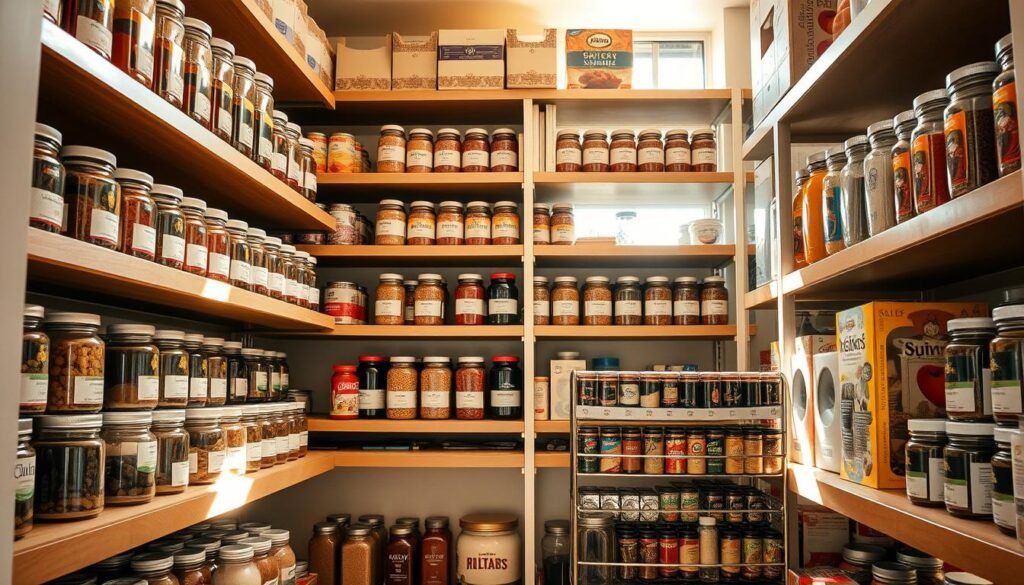
Assessing your pantry’s current state is the first step towards a more organized kitchen. To start, you’ll need to take everything out and evaluate what you have.
Empty and Evaluate Your Space
Begin by emptying your pantry space completely, or section by section if that’s less overwhelming. This allows you to see exactly what you’re working with and assess the available storage space.
Identify What’s Working and What Isn’t
As you remove items, create separate piles: keep, discard, donate, and relocate. You’ll be surprised how many things don’t belong in your pantry. Pay attention to what’s working and what’s not, and identify areas that need improvement.
Take Inventory and Discard Expired Items
This is the perfect time to check expiration dates and discard any items that are past their prime. By doing so, you’ll be able to streamline your pantry and make the most of your storage capacity.
Planning Your Pantry Space Management Strategy
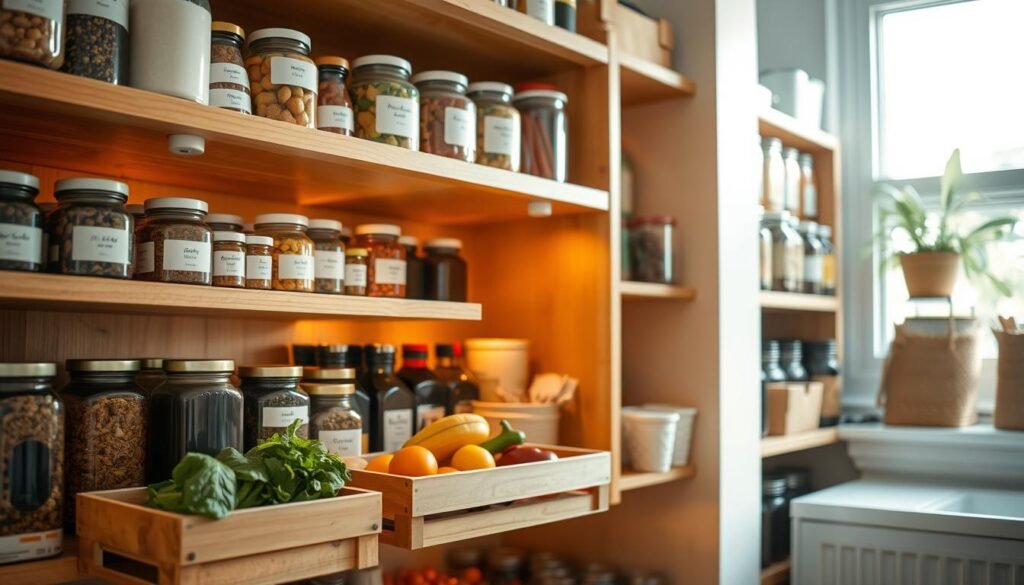
To maximize your pantry’s potential, you need a tailored space management strategy. Before diving into storage solutions, take a step back and assess your needs and habits. This will help you create a functional and efficient pantry space.
Measuring Your Space Before Purchasing Solutions
Start by measuring your pantry space carefully, including shelf width, depth, and height between shelves. This ensures that any storage solutions you purchase will fit properly. Accurate measurements are key to a well-organized pantry.
Creating Functional Zones Based on Usage
Consider creating functional “zones” in your pantry based on how you use items. For example, you might have a baking zone, breakfast zone, snack zone, and dinner ingredients zone. This approach helps in categorizing your storage needs effectively.
Prioritizing Accessibility for Frequently Used Items
Place your most frequently used items at eye level where they’re easiest to see and grab. Less-used specialty items can go on higher or lower shelves. This strategy enhances the usability of your pantry.
By following these steps, you can develop a comprehensive pantry space management strategy that suits your needs. Remember to map out your plan on paper before implementing it, considering the flow of items from the pantry to the preparation areas. Don’t forget to account for seasonal items that may need to rotate in and out of prime pantry real estate.
| Zone | Items | Accessibility |
|---|---|---|
| Baking Zone | Flour, Sugar, Baking Powder | Eye Level |
| Snack Zone | Nuts, Dried Fruits, Snacks | Lower Shelves |
Selecting the Right Storage Solutions

When it comes to pantry organization, choosing the right storage solutions is crucial for maintaining a clutter-free space. The perfect containers make organization easier to maintain long-term, and it’s worth considering what will work best for your specific needs.
Clear Containers: Pros, Cons, and Best Uses
Clear containers offer the significant advantage of visibility—you can instantly see what you have and how much remains without opening anything. This is particularly useful for staples like cereal, rice, pasta, quinoa, couscous, and oatmeal. As one organizer noted, “I can’t tell you how many duplicate bags of jasmine rice I’ve purchased just because I couldn’t easily take inventory of it before I hit the store.” Consider airtight, clear containers for items that need to stay fresh. However, they might not be the best choice for items that are sensitive to light.
Bins, Baskets, and Organizers for Different Items
Bins and baskets work wonderfully for grouping similar items—use them for snack packets, seasoning mixes, or baking supplies that don’t need airtight storage. When selecting bins and baskets, consider their practicality and how they fit with your pantry’s layout. For instance, you can use baskets for storing root vegetables or bags of snacks.
Budget-Friendly Alternatives and Repurposed Solutions
Don’t feel pressured to buy all new storage solutions—repurposed glass jars, takeout containers, and even shoeboxes can be effective pantry organizers on a budget. Get creative with what you already have to save money and reduce waste. For example, you can use old mason jars for storing spices or small snacks.
By choosing the right storage solutions, you can create a pantry that’s not only organized but also visually appealing. Consider measuring your shelves and items before purchasing storage solutions to ensure they’ll fit properly and maximize your available space.
Maximizing Vertical Space in Your Pantry
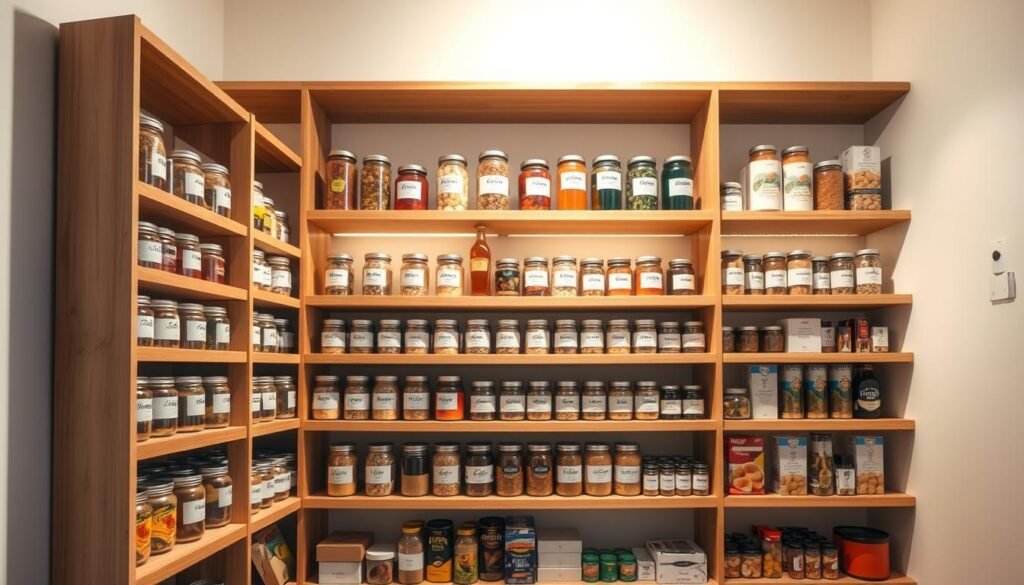
When it comes to pantry organization, one crucial aspect often overlooked is the vertical space between shelves. You’ve likely lost track of items that have disappeared into the back of a shelf at some point. Optimizing this space can significantly enhance your pantry’s storage capacity and make it more functional.
Utilizing Shelf Risers and Tiered Organizers
Shelf risers and tiered organizers are game-changers for visibility, allowing you to see items in the back row without moving everything in front of them. For instance, The Container Store Expand-A-Shelf is a highly recommended solution for maximizing vertical space. By using these, you can double or even triple your shelf space, making the most of the area between your existing shelves.
Door and Wall Storage Options
The inside of your pantry door provides valuable additional storage space. Consider adding over-the-door organizers, spice racks, or hook systems to utilize this area. These solutions can help keep frequently used items within easy reach while keeping your shelves less cluttered.
Solutions for Deep Shelves and Hard-to-Reach Areas
For deep shelves where items tend to get lost, pull-out drawers or bins can transform these frustrating spaces into functional storage. Additionally, Lazy Susans (turntables) work wonders in corner spaces or for small items like spices and condiments, allowing you to rotate and see everything with a simple spin.
By implementing these strategies, you can make the most of your pantry’s vertical space, ensuring that every item is visible and accessible. Whether it’s utilizing shelf risers, door storage, or solutions for deep shelves, maximizing vertical space is key to a well-organized pantry.
Effective Categorization and Grouping Strategies
Effective categorization can make or break your pantry’s functionality. As Naeemah Ford Goldson, a professional organizer and NABPO founder, noted, “Instead of placing all 14-ounce cans or 18-ounce jars together, sort your foodstuffs into themed categories.” This approach ensures that your pantry is not just tidy but also functional.
Organizing by Theme vs. Size
When deciding how to categorize your pantry items, consider organizing by theme rather than size. This makes more sense for how you actually use your pantry. For example, grouping baking supplies, snacks, and condiments can make meal preparation more efficient. As Goldson said, “Some of these categories will be obvious, including: snacks, baking supplies, drinks and drink mixes, condiments and spreads, oils, vinegars, broths, and other cooking liquids.”
Creating Meal-Based Groupings
For families who cook from recipes regularly, creating meal-based groupings can be incredibly efficient. Imagine having all your taco night or pasta dinner ingredients stored together! This approach streamlines meal preparation and makes cooking more enjoyable.
Special Considerations for Families with Children
Families with children have special considerations when it comes to pantry organization. Creating a designated “kid zone” with parent-approved snacks at a height children can reach independently encourages self-sufficiency. Consider grouping snacks and other kid-friendly items to make mealtime more accessible.
By implementing these categorization strategies, you can create a pantry that is not only organized but also functional and easy to navigate.
Labeling Systems That Actually Work
Effective labeling is the backbone of a well-organized pantry, making it easy to find what you need when you need it. According to Green, “Labeling is not that big of a deal. It really depends on the user.” If you’re using see-through containers, you might not need labels for everything. However, for similar-looking ingredients or for maintaining a uniform look, labels can be very helpful.
Simple vs. Elaborate Labeling Methods
When it comes to labels, simplicity is often the best policy. Many professional kitchens use painter’s tape and a permanent marker to label items, a method that’s both effective and easy to implement. Consider what information your labels need to include—item name, purchase date, or expiration date. For households with multiple members, clear labeling can help maintain order and make meal prep more efficient.
Tracking Expiration Dates Efficiently
To keep track of expiration dates, try using masking tape and a marker to note the date when you open an item. You can also create a “use first” section for items approaching their expiration date. This simple system helps ensure that older items are used before they go bad, reducing waste and saving you money.
- A good labeling system maintains order in your pantry organization, even with multiple users.
- Painter’s tape and a permanent marker are all you need for effective labels.
- Consider including purchase dates or expiration dates on your labels.
- Simple labeling systems are more sustainable long-term than elaborate ones.
Maintaining Your Organized Pantry Long-Term
The key to a long-term, organized pantry is consistent upkeep. You’ve invested time and effort into organizing your pantry, and now it’s essential to maintain it.
Weekly Maintenance Routines
Establishing a simple weekly routine can make a significant difference. Spend just 5-10 minutes realigning items, checking for expired food, and wiping down shelves. This habit will help you stay on top of your pantry’s organization.
Integrating Organization with Grocery Shopping
Merge your pantry maintenance with your grocery shopping routine. Before making a list, “shop” your pantry to avoid buying duplicates. When unpacking groceries, take an extra minute to transfer items to their proper containers. This small effort pays huge dividends in maintaining your pantry’s organization.
| Maintenance Task | Frequency | Benefits |
|---|---|---|
| Realign items and wipe shelves | Weekly | Maintains order and prevents clutter |
| “Shop” your pantry before grocery shopping | Before each grocery trip | Avoids duplicate purchases and reduces waste |
| Deep clean and reassess pantry | Quarterly | Ensures the pantry remains functional and adapted to changing needs |
Conclusion
Transforming your pantry into a well-organized space is more than just a decluttering task; it’s about creating a more efficient kitchen. By implementing effective pantry space management strategies, you’re not just organizing a space—you’re enhancing your entire cooking experience.
A well-organized pantry saves you time during meal preparation, reduces stress when cooking, and can even inspire more home-cooked meals. The benefits are numerous, from reduced food waste and fewer duplicate purchases to a more enjoyable cooking process.
Remember, the best pantry organization system is one that works specifically for your household’s needs and habits. Don’t be afraid to adjust your system as you go—the best pantries evolve with your household’s changing needs. By following the strategies outlined in this guide, you’ll be on your way to creating a more efficient, enjoyable kitchen experience.
The satisfaction of opening a well-organized pantry where everything has its place is truly one of life’s simple pleasures!
FAQ
How often should I clean out my kitchen storage areas?
It’s a good idea to thoroughly clean out your kitchen storage areas at least twice a year, and perform a quick tidy every week to maintain organization.
What are the best containers for storing dry goods like rice and pasta?
Clear, airtight containers like those from OXO or Rubbermaid are ideal for storing dry goods, as they keep contents fresh and are easy to label.
How can I maximize the back of a door in my kitchen for storage?
You can use over-the-door storage racks, hooks, or adhesive organizers to hang items like spice racks, bags of snacks, or cleaning supplies, making the most of this often-wasted space.
What’s the best way to organize canned goods and other heavy items?
Store heavy items like canned goods on lower shelves or in easy-to-reach locations to avoid straining your back, and consider using a Lazy Susan to make the most of corner cabinets.
How can I keep track of expiration dates for perishable items?
Use a labeling system that includes the date you purchased or opened an item, and consider implementing a “first in, first out” policy to ensure older items are used before they expire.
Are there any budget-friendly alternatives to expensive storage solutions?
Yes, you can repurpose items like mason jars, cardboard boxes, or old crates to create unique and functional storage solutions that fit your budget.
How can I involve my family in maintaining our organized kitchen?
Assign tasks to each family member, such as putting away their own snacks or helping with meal prep, to encourage everyone to take ownership of maintaining your kitchen’s organization.
